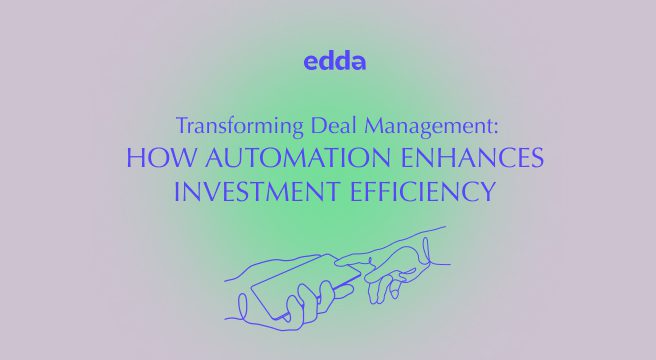As a venture capitalist (VC), crafting a successful portfolio demands a fine blend of intuition, experience, and structured methodology. The objective is to strike a balance between managing risk and maximizing returns, a dance that necessitates a keen understanding of startup dynamics, market trends, and economic variables.
Among the multiple frameworks employed by venture capital firms worldwide, the Bessemer portfolio model holds a distinguished place, having demonstrated time and again its effectiveness in managing a venture capital portfolio successfully.
This article offers an in-depth analysis of the Bessemer portfolio model, shedding light on its guiding principles, its framework, and its implications for venture capital portfolio management. In addition, discover how Edda’s venture capital portfolio management software can be a major asset to your firm.
Understanding the Bessemer Portfolio Model
The Bessemer Portfolio Model is a quintessential approach towards venture capital investment, combining the principles of concentrated diversification, sector and stage diversity, founders’ vision, market opportunity, and value creation. This approach has been perfected by Bessemer Venture Partners (BVP), a significant player in the venture capital landscape for over a century.
BVP is renowned for its daring investments in emerging, high-growth sectors such as SaaS, cybersecurity, and healthcare IT. The firm’s bold bets reflect its focus on the “big picture,” recognizing the potential of nascent markets early on. The firm also emphasizes backing strong, visionary founding teams with transformative ideas and unwavering determination, elements that they deem vital for startup success. Furthermore, BVP embodies the principle of patient capital, committing to its portfolio companies for the long haul.
The Bessemer portfolio model typically maintains a portfolio of about 70 to 80 active companies. This principle of concentrated diversification allows for considerable portfolio diversification, mitigating the risks associated with early-stage investments, without diluting the firm’s focus or management capacity.
Diversification forms the bedrock of this model. BVP makes calculated investments across a wide range of sectors, thereby mitigating industry-specific risks and capturing growth opportunities in different market segments. They also diversify across different startup stages, from seed to growth-stage companies, managing their risk-reward profile dynamically.
The model also emphasizes understanding the founders’ vision and potential market opportunity. BVP seeks founders with a long-term vision, backed by disruptive ideas that can redefine industries. They balance this with a scrutiny of the market dynamics and the unique value proposition of the startup, ensuring a balance between vision and market opportunity.
The Bessemer portfolio model extends beyond merely providing financial support to startups. The firm adopts an engaged partnership approach, offering strategic guidance, operational support, and networking opportunities. This active involvement helps BVP to create tangible value, aiding startups in overcoming growth challenges, seizing opportunities, and scaling effectively.
The Framework of the Bessemer Portfolio Model
The application of Bessemer’s principles in portfolio management is best understood through the “Roadmap” and “Anti-Portfolio” concepts:
The Roadmap: Guiding Investments through Industry Vision and Transformative Trends
Bessemer Venture Partners (BVP) takes a strategic approach to investments in high-growth sectors through its unique construct—the roadmap. This critical document serves as a comprehensive strategic guide, outlining the firm’s vision for the industry’s future. However, it’s more than just a projection of possible future states. The roadmap dives into the transformative trends within the industry, highlighting potential game-changing elements and opportunities.
In essence, the roadmap is a thoughtfully curated blueprint of the industry’s future landscape, designed to inform and guide BVP’s investment strategy. The firm uses the roadmap to pinpoint startups that are poised to ride on, and perhaps steer, the significant transformative waves within their sectors. It allows BVP to identify and invest in ventures that have the potential to redefine industry norms and emerge as future leaders.
This roadmap-based approach ensures that BVP’s investment decisions are forward-thinking and proactive. It facilitates the firm in aligning its portfolio with future market trends, contributing to the portfolio’s potential for high returns and success.
The Anti-Portfolio: Learning from Missed Opportunities
In the venture capital industry, where evaluating startups is as much art as it is science, even the most seasoned investors may sometimes miss the mark. Bessemer Venture Partners acknowledges this reality through its distinctive practice—the Anti-Portfolio.
The Anti-Portfolio is a catalog of companies that BVP had the opportunity to invest in but ultimately passed on. Some of these companies have gone on to achieve tremendous success, making the Anti-Portfolio a testament to missed opportunities. Companies like Apple, Google, and Facebook, now global tech behemoths, feature in BVP’s Anti-Portfolio.
While it might seem unusual for a venture firm to maintain such a record, the Anti-Portfolio serves a crucial function. It acts as a continual, humbling reminder of the imperfections in judgment and decision-making processes, even in a seasoned firm like BVP.
Bessemer uses the Anti-Portfolio to foster a culture of continuous learning and improvement. By examining the reasons why they passed on these opportunities, BVP can extract valuable lessons to sharpen their investment thesis and refine their decision-making processes. This iterative learning mechanism helps BVP avoid similar misjudgments in the future, enhancing their capability to identify and invest in high-potential startups.
The Anti-Portfolio concept underscores a core principle in venture investing—humility. It is a constant reminder that no investor is infallible, and learning from past mistakes is integral to making more informed, effective decisions in the future.
How Edda Can Help You Implement the Bessemer Portfolio Model
Maintaining a diversified and balanced portfolio akin to the Bessemer model is an intricate task, demanding careful deal evaluation, portfolio management, and strategic planning. Here, Edda, a fintech firm, provides an invaluable solution with its best portfolio management software suite. Edda’s tools assist VCs in managing deal flow, tracking portfolio companies, and facilitating funding rounds.
Edda’s software for venture capital firms offers a collaborative environment for venture capitalists. The Shared Pipelines feature allows VCs to share dealflow pipelines, promoting a more informed and efficient investment decision-making process. The platform’s real-time insights and efficient data management further aid in maintaining a healthy, diversified portfolio, mirroring the successful practices of the Bessemer model.
In conclusion, while the Bessemer Portfolio Model offers an effective framework for venture capital portfolio management, tools like Edda’s deal flow management software can significantly enhance its implementation. By utilizing Edda’s platform, VCs can keep pace with the dynamic startup landscape, make informed investment decisions, and ultimately, build a successful venture capital portfolio.









